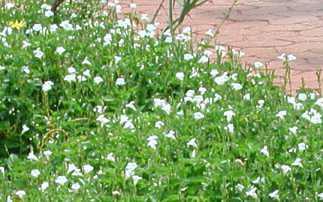Asystasia gangetica
Asystasia gangetica (L.) T.Anderson subsp. micrantha (Nees) Ensermu
Family: Acanthaceae
Common names: creeping foxglove (Eng.); Isihobo (Zulu)
Introduction
If you have a large expanse that needs covering, try the magic of this African beauty. Creeping foxglove is the most rewarding and friendliest of all the groundcovers (it may even prove too friendly in a small garden!).

Description
Description
This is an attractive, fast-growing, spreading, herbaceous groundcover that grows from 300 mm to 600 mm in height. The stems root easily at the nodes. Leaves are simple and dark green. It produces a cream-coloured flower with tessellated purple markings on the palate (lower petal of the corolla) in spring and summer.
; 
Flowers are produced over a long period and are followed by capsules with brown seeds. It is semi-hardy, and young plants require protection in areas of heavy frost. In tropical areas it can grow rampantly.
Conservation Status
Status
Aystasia gangetica is not threatened in any way as is listed as LC (Least Concern) in the Red Data List. According to the Global Invasive Species Database this creeper has caused major problems in the ecosystems of the Pacific Islands. It is potentially highly invasive.
Distribution and habitat
Distribution description
Aystasia gangetica is widely distributed from tropical Asia to southern Africa. The subspecies found in South Africa differs from the Asian plant which usually has larger pink flowers. The South African subspecies occurs along the eastern coastal areas of the country and in the north. It is recorded from the Eastern Cape, KwaZulu-Natal, Swaziland, Limpopo Province, Mpumalanga, Botswana and Namibia.
Derivation of name and historical aspects
History
Asystasia means inconsistency and relates to the fact that the corolla is more or less regular, which is unusual in the family Acanthaceae. The word gangetica is derived from the Ganges River in India where it is presumed the species occurs.
Ecology
Ecology
In nature Asystasia has developed a good relationship with the honeybee that pollinates the flowers. The white petals of the flowers and purple blue strip on the lower petal attract the insect, indicating to the honeybee where to find the nectar. The flowers also serve as food for beetles and the plant receives visits from ants. The flowers are very attractive to butterflies too.
Uses
Use
This ground cover can be used as a mass planting under large trees and borders in full sun, semi-shade or full shade. It is also a good container plant. Leaves have been eaten as spinach by the local people.
Growing Asystasia gangetica
Grow
This ground cover thrives in semi-shade and will also grow in sunny spots if it receives adequate moisture. It can be planted in any soil in the garden, but will do better if plenty of compost is added. Propagate from cuttings taken after flowering or by removing rooted runners (small plants must be protected from frost).
Please note that Aystasia gangetica can be highly invasive and should be planted with care. Its ability to reproduce by vegetative propagation can result in it smothering surrounding vegetation with its herbaceous layer.
Watch out for the most common pest, dodder (Cuscuta campestris). It is a slender, leafless, parasitic herb with yellow, twining stems reaching a height of up to 2 m and forming dense patches up to 5 m across. It forms little whitish flowers in November to April. The fruit are greenish yellow capsules. The affected plants must be removed and destroyed immediately.

References
- Edwards, T.J. & Getliffe Norris, F.M. 1993. Asystasia gangetica. The Flowering Plants of Africa 52: t. 2076.
- Jackson, W.P.U. 1990. Origins and meaning of names of South African plant genera. Ecolab, Botany Department, University of Cape Town.
- Joffe, P. 1993. The gardener's guide to South African plants. Tafelberg, Cape Town.
- Pooley, E. 1998. Field guide to wild flowers of Kwazulu-Natal and the eastern region. Natal Flora Publications Trust, Durban.
- Retief, E. & Herman, P.P.J. 1997. Plants of the northern provinces of South Africa: keys and diagnostic characters. Strelitzia 6.
Credits
Elliot Lithudzha
Pretoria NBG
June 2004
With additions by
Yvonne Reynolds
Plant Attributes:
Plant Type: Ground Cover
SA Distribution: Eastern Cape, KwaZulu-Natal, Limpopo, Mpumalanga
Soil type: Loam
Flowering season: Spring, Early Summer
PH: Neutral
Flower colour: White
Aspect: Full Sun, Shade, Morning Sun (Semi Shade), Afternoon Sun (Semi Shade)
Gardening skill: Easy
Special Features:
Horticultural zones









Rate this article
Article well written and informative
Rate this plant
Is this an interesting plant?
Login to add your Comment
Back to topNot registered yet? Click here to register.